The Skinny on Fats

What you eat can affect your LDL (bad) cholesterol. Knowing which fats raise LDL cholesterol and which ones don’t can help you lower your risk of heart disease and stroke.
Your body naturally produces all the LDL cholesterol you need. Eating foods containing saturated and trans fats causes your body to produce even more LDL — raising the level of “bad” cholesterol in your blood.
It’s worth understanding the different kinds of fats: Saturated, trans and unsaturated.
Saturated fat
Saturated fats are fat molecules that are “saturated” with hydrogen molecules. They are typically solids at room temperature.
Saturated fats occur naturally in many foods — primarily meat and dairy products. Beef, lamb, some cuts of pork and poultry (with the skin on) contain saturated fats, as do butter, cream and cheese made from whole or 2% milk. Plant-based foods that contain saturated fats include coconut, coconut oil and cocoa butter, as well as palm oil and palm kernel oil (often called tropical oils).
For people who need to lower their cholesterol, the American Heart Association recommends reducing saturated fat to less than 6% of total daily calories. For someone eating 2,000 calories a day, that’s about 11 to 13 grams of saturated fat.
Trans Fat
Trans fats (or trans fatty acids) are created in a process that adds hydrogen to liquid vegetable oils to make them more solid. Another name for trans fats is “partially hydrogenated oils.”
Trans fats raise your bad (LDL) cholesterol levels and lower your good (HDL) cholesterol levels. These changes are associated with a higher risk of heart disease and stroke.
Trans fats are found in many fried foods. Baked goods, such as pastries, pizza dough, pie crust, cookies and crackers also can contain trans fats.
Since 2006, the FDA has required trans fat content to be listed on the Nutrition Facts panel of packaged foods. In recent years, many major national fast-food chains and casual-dining restaurant chains have announced they will no longer use trans fats to fry or deep-fry foods.
The AHA recommends that adults who would benefit from lowering LDL cholesterol eliminate trans fat from their diet.
To find the amount of trans fats in a particular packaged food, look at the Nutrition Facts panel. Companies must list any measurable amount of trans fat (0.5 grams or more per serving) in a separate line in the “Total Fat” section of the panel, directly beneath the line for “Saturated Fat.” This means if a food package states 0 grams of trans fats, it might still have some trans fats if the amount per serving is less than 0.5 g. Make sure to check the ingredients list for “partially hydrogenated oil.”
Unsaturated fat
The two kinds of unsaturated fats are monounsaturated and polyunsaturated. Both of these unsaturated fats are typically liquid at room temperature.
Eaten in moderation, both kinds of unsaturated fats may help improve your blood cholesterol when used in place of saturated and trans fats.
Unsaturated fats are in fish, such as salmon, trout and herring, and plant-based foods such as avocados, olives and walnuts. Liquid vegetable oils, such as soybean, corn, safflower, canola, olive and sunflower, also contain unsaturated fats.
Limiting saturated and trans fats
Here are some ways to lower your intake of saturated and trans fats:
- Maintain a diet that emphasizes fruits, vegetables, whole grains, fat-free or low-fat dairy products, poultry, fish and nuts. Also limit red and processed meats and sugar-sweetened foods and beverages.
- Choose naturally occurring unhydrogenated vegetable oils such as canola, safflower, sunflower or olive oil.
- Look for processed foods made with unhydrogenated oil rather than saturated fat or hydrogenated (or partially hydrogenated) vegetable oils.
- Use soft margarine instead of butter and choose soft margarines (liquid or tub varieties) over harder stick forms. Look for “0 g trans fat” on the Nutrition Facts label.
- Doughnuts, cookies, crackers, muffins, pies and cakes are examples of foods high in trans fat. Don’t eat them often.
- Limit commercially fried foods and baked goods made with shortening or partially hydrogenated vegetable oils. These foods are very high in fat, and it’s likely to be trans fat.
- Limit fried fast food. Commercial shortening and deep-frying fats are still made by hydrogenation and contain saturated and trans fats.
Consider using a food diary to keep track of what you eat. It’s a handy way to evaluate the healthy, not-so-healthy and unhealthy foods you’re making a part of your diet.
Learn more about dietary fats and cooking to lower cholesterol.






